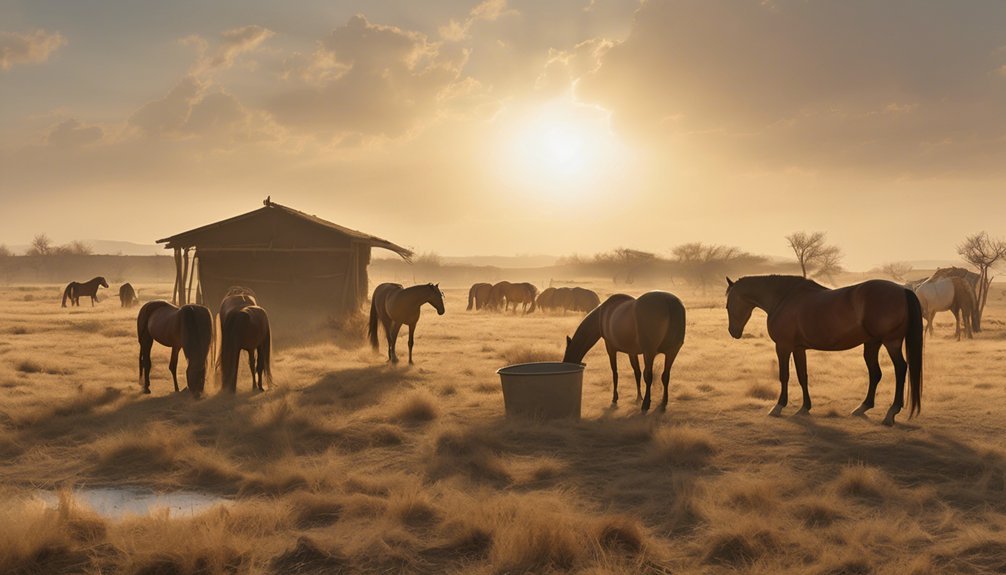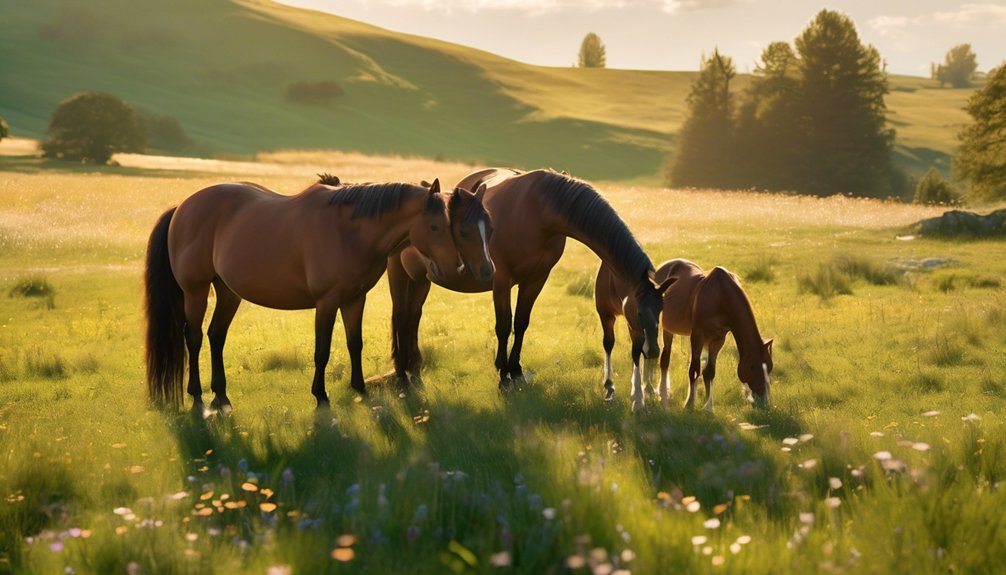
A horse's energy is like a finely tuned engine, needing the right fuel to perform optimally. To boost your horse's energy without tipping into hyperactivity, you'll want to consider a balanced diet, appropriate exercise, and a calm training environment. Understanding how to achieve this balance is crucial for maintaining your horse's focus and stamina. What strategies can you implement to ensure your horse stays energized yet calm?
Key Takeaways
- Focus on providing high-quality, easily digestible carbohydrates like oats or beet pulp to boost energy without causing hyperactivity.
- Incorporate omega-3 fatty acids from flaxseed oil to support sustained energy levels and overall health without stimulating excess energy.
- Ensure a balanced intake of B vitamins to promote efficient energy metabolism and avoid energy spikes that lead to hyperactivity.
- Implement structured exercise routines that gradually increase intensity to build stamina without overwhelming the horse.
- Create a calm training environment with familiar surroundings and gentle cues to maintain focus and prevent anxiety-related hyperactivity.
Understanding Equine Energy Needs

When you consider your horse's energy needs, it's essential to understand that these requirements vary based on factors like age, breed, workload, and overall health.
Energy metabolism plays a crucial role in how efficiently your horse converts feed into usable energy. A young, active horse will require more energy than an older, less active one, as their energy balance must support growth and daily activities.
Additionally, working horses need extra calories to sustain their performance levels. Monitoring your horse's condition can help you adjust their diet to meet these demands.
The Role of Nutrition in Energy Levels
Nutrition plays a critical role in determining your horse's energy levels, as the right balance of nutrients can significantly affect performance and overall health.
Focus on energy balance by providing adequate carbohydrates, fats, and proteins tailored to your horse's specific needs. Nutrient timing is essential; feeding your horse at strategic intervals can optimize energy availability during workouts or competitions.
For instance, a pre-exercise meal rich in easily digestible carbs can fuel performance without causing hyperactivity. Remember, it's not just about the quantity of feed, but also the quality and timing that matter.
Recommended Supplements for Sustained Energy

To enhance your horse's energy levels, consider incorporating specific supplements that can support sustained performance.
Natural energy boosters like beet pulp and alfalfa are excellent choices; they provide digestible fiber and protein, promoting endurance without causing hyperactivity. Omega-3 fatty acids, found in flaxseed oil, also help maintain an essential nutrient balance, supporting overall health and energy.
Additionally, B vitamins play a crucial role in energy metabolism, so a quality vitamin B complex can be beneficial. Always consult with your veterinarian before introducing new supplements, ensuring they align with your horse's individual needs.
Tailoring Exercise Routines for Optimal Stamina
Tailoring exercise routines for optimal stamina involves understanding your horse's unique capabilities and gradually building their endurance.
Start by incorporating structured workouts that promote conditioning without overwhelming them. Here are four key components to consider:
- Interval Training: Alternate between high-intensity bursts and recovery periods to enhance aerobic capacity.
- Endurance Rides: Gradually increase ride distances to develop stamina, ensuring you monitor your horse's comfort.
- Varied Terrain: Include hills and varied surfaces to engage different muscle groups, promoting balanced strength.
- Rest Days: Schedule regular rest days to allow for recovery, preventing fatigue and overexertion.
Creating a Calm Environment for Training

Creating a calm environment for training is essential, as it directly impacts your horse's focus and performance.
Start by ensuring calm surroundings; minimize noise and distractions, and choose a familiar training area. This familiarity helps your horse feel secure, promoting a more relaxed state.
Consistency is key; establish a routine that your horse can anticipate, enhancing their comfort during sessions. Use gentle cues and maintain a soft demeanor to foster trust.
Incorporate short, positive training intervals, allowing for breaks to keep your horse engaged without overwhelming them.
Recognizing Signs of Hyperactivity
How can you identify when your horse is becoming hyperactive? Recognizing hyperactivity triggers early can help you manage your horse's energy effectively.
Watch for these behavioral signs:
- Restlessness: Notice if your horse paces or shifts weight frequently.
- Increased Vocalization: Pay attention if your horse whinnies or neighs more than usual.
- Excessive Energy: Look for sudden bursts of speed or jumping in place.
- Difficulty Focusing: If your horse seems easily distracted or has trouble following commands, it may be hyperactive.
Monitoring and Adjusting Strategies for Your Horse

What strategies can you implement to effectively monitor and adjust your horse's energy levels?
Start by closely observing your horse's behavior during and after exercise. Look for signs of fatigue or restlessness, which can guide your adjustments.
Keep a journal to track patterns in energy levels, noting factors like diet, turnout time, and riding intensity. This data will help you identify what works best for your horse.
When adjusting routines, gradually modify feeding schedules and exercise duration to find the optimal balance. Remember, small changes can lead to significant improvements.
Regularly reassess your horse's response to these adjustments, ensuring you maintain a healthy energy level without triggering hyperactivity. Your attentive approach will foster a stronger bond with your horse.
Frequently Asked Questions
Can Age Affect a Horse's Energy Levels?
Yes, age influences a horse's energy levels. As they mature, you may notice a correlation between their age and vitality. Older horses often require more care to maintain their energy without causing hyperactivity or fatigue.
How Does Weather Impact a Horse's Stamina?
Weather effects can significantly impact your horse's stamina variations. High temperatures can lead to fatigue, while cold, windy conditions might reduce energy. Monitor your horse closely, adjusting exercise routines based on the weather for optimal performance.
What Common Health Issues Affect Energy in Horses?
You might not realize it, but common health issues like muscle disorders and metabolic issues can significantly affect your horse's energy levels. Keeping an eye on their health helps maintain their stamina and overall vitality.
Are There Specific Breeds Known for High Energy?
When considering high-energy horse breeds, Arabian horses and Thoroughbred racehorses stand out. Their athleticism and endurance are remarkable, making them ideal for various equestrian activities. Understanding their traits can help you choose the right companion.
How Do Different Riding Styles Influence Energy Needs?
Different riding styles dramatically shape energy needs. Dressage demands precision and concentration, requiring sustained energy, while western work emphasizes agility and stamina, leading to varied energy requirements. Your horse's training impacts its overall vitality and performance.
Conclusion
By understanding your horse's energy needs and implementing a balanced diet, tailored exercise, and a calm training environment, you can boost their energy without the risk of hyperactivity. Think of it as unlocking a treasure chest of stamina and focus! Regularly monitor your horse's response and adjust your strategies to keep them performing at their best. With the right approach, you can transform your horse into an energy powerhouse, ready to tackle any challenge with ease.





